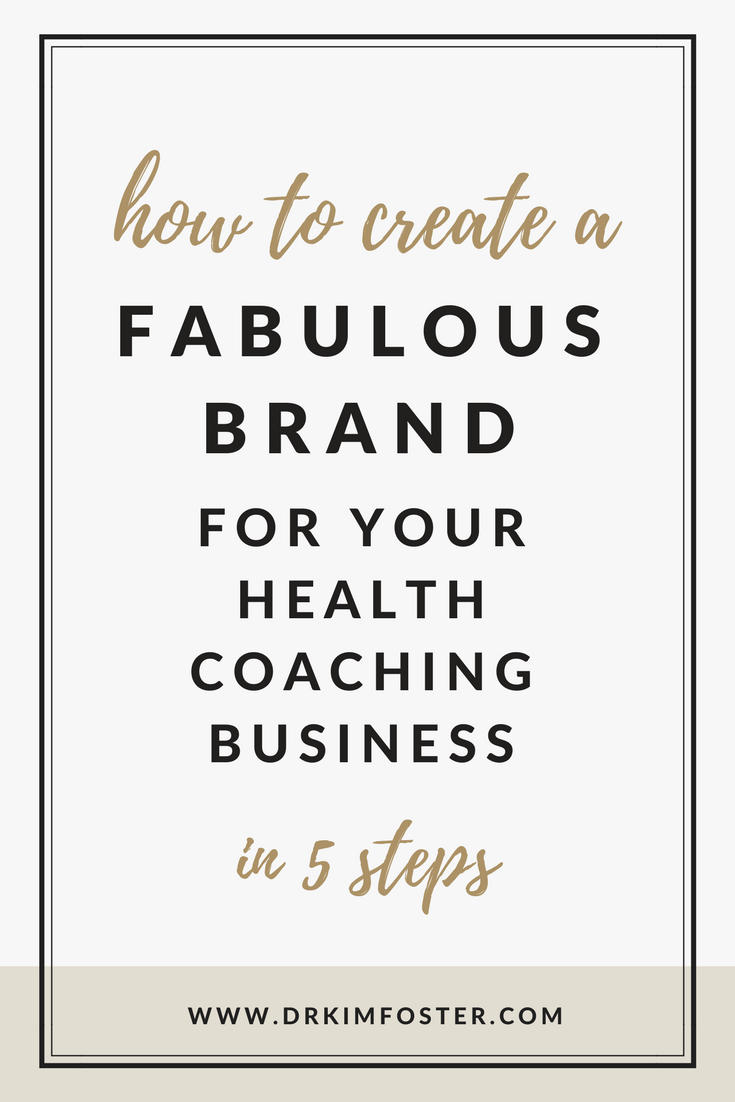If you’re in business, you’re a brand. As a health coach, it’s an important part of attracting people to you — and not just anyone, but your IDEAL client. A high quality brand identity sets you apart from the competition.
I know you’ve seen beautiful brands and thought: I would *love* my brand to look like that. But…professional branding can be expensive. And you may not have the budget for that just yet. Does that mean you don’t get to have a beautiful brand? Not at all. Let me walk you through a DIY branding process in 5 easy steps.
BRANDING IS A PROMISE
Before we start, it’s important to know that designing your brand is about so much more than just choosing a nice color scheme. In essence, branding is the promise you make to your audience. It is the expectation you establish with them. And it helps them choose you over the competition--if they are the right fit. It does, of course, include color palette and your logo, but it goes way beyond that, into wording, lexicon, tone, images, and emotion. It’s all about how people feel when they engage with your brand.
Without further ado, let’s talk about those five steps to creating your own business branding.
STEP ONE: Create a Buyer Persona
Before you can even get started with deciding on the various elements (like color, lexicon, etc), you need to have a solid foundation in your business identity–specifically, your ideal client avatar.
The truth is, your brand is not really about YOU. Or, I should say, it’s not ONLY about you. It’s actually about how you want your ideal client to feel when they interact with you, your business, and your online presence. Truth be told, branding is fundamentally about emotion. It’s a feeling you’re generating and a promise you’re making to your prospective clients.
So first, let’s define your ideal client–the people in whom you want to elicit an emotional reaction.
Pull out your journal or open a fresh document on your computer and start writing down everything you know about your ideal client. Start with simple demographics, like her age, life stage, career, whether she has kids. And then move into meatier topics: what does she struggle with? What does she want? What does she dream about? Keep going, writing everything you can think about. What does she consume in terms of entertainment? What does she value? What is her worldview? What does she spend money on? What are her favorite brands? Really create a living, breathing picture in your mind of the EXACT client you would love to work with–and who would love to work with you.
STEP TWO: Collect Brand Inspiration
Here I want you to start collecting brand inspiration. This is to get a deeper sense of the sorts of visuals and brand elements that you are attracted to.
There are a number of ways to do this, but in my opinion, this is practically what Pinterest was made for. Think of brands that you are most attracted to, the brand models you feel inspired by.
If there’s a picture you like, a slogan, a color palette, a font combination…collect it. You’re not *choosing* at this stage, just gathering a whole bunch of sensory inspiration. Stuff yourself full of it. The whittling down stage will come later. Right now, you’re just looking for inspo.
Don’t just stick to inspiring images from your own field–go to other industries and sectors. If you’re a health coach, don’t just pin other health-related images. Collect images from your favorite fashion brand, book covers, travel images…whatever! Also, if you’re feeling so inclined, don’t limit yourself to merely visual inspiration. If there’s a song that inspires you and speaks to you–save that in some format. How about a particular scent? Carrie Green (of the Female Entrepreneur Association) said in an interview once that she kept an inspiration box when she was just starting out that included a bottle of perfume about how she wanted her life and company to smell one day, when she’d really “made it”.
You can take this a step further and try to identify and name the reasons why you’re attracted to these elements. Step back and look at it all together. What are some common threads? These will be your signposts to what you’re all about. What makes your brand unique.
As an example, some of my favorite inspirational brands: Jo Malone, Kate Spade, Lululemon, Nespresso, Coach. What do I love about these brands: Luxury, but fun. A premium experience, high quality. Stylish. Not stuffy. Modern. Clean lines. Feminine colors. A bit soulful.
STEP THREE: Clarify Your Brand VISION
Now it’s time to put into words the kind of feeling you want your prospective customers to have when they encounter your brand.
In other words, hone your brand VISION. You do this by blending what you know about your ideal client and what you feel yourself about brands you love…and synthesizing it into the sort of brand EXPERIENCE you want your ideal client to have.
The best brands in the world inspire us to feel a particular set of emotions. They tap into our own self-image and our dreams of who we want to be. We feel drawn to brands that give us something to believe in.
So I want you to think about how you want your ideal client to feel when she encounters you–whether it’s your website, your social media profile–whatever. What is the emotion you want to elicit?
Start by free-form writing or simply brainstorming. Then look it all over, and whittle it down to a short list of words that truly DEFINE your brand (3-5 words are ideal).
Here are some ideas to get your juices flowing.
When your ideal client encounters your brand, do you want her to feel…
- Safe, comfortable, welcome?
- Invigorated, inspired, and fired-up?
- Happy, warm, and cozy?
- Fresh, enlightened, and ready for a new start?
You see how each of these collections of words would translate to a different brand image and experience? Different color palette, different font, different word choice and messaging. So translating those desired emotions into the specific details of your brand is what we’re going to do in our very next step.
STEP FOUR: Translate Your Brand FEELING Into Tangibles
This is when we get down to the granular level of your brand ELEMENTS. You’re going to take your list of emotions from step three, use your brand inspiration from step two, and make some decisions. If you want your clients to feel inspired and excited, what colors would create that feeling? Your particular color choices would be very different from a coach who wants her clients to feel soothed and calmed.
So, use the prompts below, or a version of your own, and make some choices:
What colors convey the feeling I want to elicit in my clients, while also being authentic to me?
What fonts, or combinations of fonts, best represent my brand emotion and personality? (By the way, there are seemingly endless fonts, but Pinterest is a great spot to find appealing combinations of free fonts, so be sure to look there for inspiration.)
What words? Create a lexicon for your brand, a list of key words and phrases that reflect what you’re about. Also consider: what inspirational quotes would resonate with your ideal client? Collect those, too.
Next, consider tone of voice. Are you casual? Professional? Formal? Spiritual? Do you use slang?
What images fit with your brand vision? Here, we could be talking about graphics, icons, illustrations, photography, gifs…whatever works for you and your brand.
Consider other visual elements of your website: how much white space? Are lines: thick, thin, straight, curvy? Textures and patterns?
What would your logo look like? Of course, this is a more complex manifestation of your brand vision, and many people get a graphic designer to help them out, but you can definitely DIY this, if you so choose (try PicMonkey or Canva–check out their logo templates).
Finally, once you’ve given all these elements some serious consideration, gathering all these pieces onto a brand moodboard (whether virtual, on Pinterest, or a physical board using scissors and glue!) is an excellent exercise to help tie this all together.
STEP FIVE: Create a Style Guide
This is the tool that will help you be consistent and carry your brand across your entire online presence (and real-life presence, too). Some people call this a Brand Rules Handbook, but Style Guide also works. This can exist in a Google Doc, a physical notebook, or whatever else works for you.
Here’s a list of the elements to record in your style guide:
My three brand colors:________________________________________
My three brand fonts:
- for headlines:____________________________________
- for subheadlines:___________________________________
- for body text:______________________________________
Words/phrases that commonly appear in my branding:________________________________________________
My tone of voice:____________________________________________________________
Commonly used images/graphics/photography:___________________________________________________
Visual elements:________________________________________________________________
Logo:_________________________________________________________________
Let’s Recap!
Okay, so the steps you need to take when crafting your own brand:
- Keep your ideal client in mind and create a buyer’s persona
- Collect brand inspiration
- Clarify your personal brand vision/feeling
- Translate the vision/feeling into tangible elements
- Create consistency across all platforms with a Style Guide
But to be honest, you know what trips up many coaches when crafting their brand? It’s that very first step. Having a clear image of your ideal client–the person you’re helping, in the niche you’re working in–is a real stumbling block for many coaches.
And this is something I help coaches with a lot. If you need help clarifying your niche, go ahead and download my worksheet by clicking on the thumbnail below:
Happy Branding!
Kim xo







